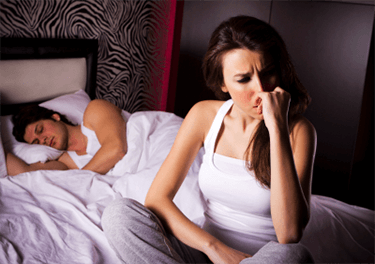Insomnia, an all too common problem, is usually attributed to stress, depression, anxiety, alcohol or caffeine use, poor sleep hygiene, restless legs syndrome, and sleep apnea. Hormonally, thyroid abnormalities, and unusually low levels of melatonin can cause insomnia as well. While all of these syndromes should be considered in evaluating insomnia, the role that PMS and female hormones (progesterone, estrogens) play in insomnia is rarely discussed.
Background
In healthy women sleep disturbances occur twice as often as they do in men. Insomnia is also often more common in the 1-2 weeks before menstruation begins (the luteal phase of the cycle), when compared with the first half of the menstrual cycle. The sleep regulating role of female hormones looms even larger in women with PMS (also known as PMDD, premenstrual dysphoric disorder), and women in the post-menopausal and postpartum phases of the reproductive cycle.
The most common finding in studies of healthy menstruating women is a reduction in dream sleep (REM sleep) in the luteal phase of the monthly cycle. REM sleep usually occurs at the time of the night when body temperature is lowest, but progesterone raises body temperature, thereby (presumably) reducing REM sleep. It is possible that variations in progesterone (which acts in some ways like valium acts, at the GABA-a receptor) and its metabolites may affect sleep quality directly, or via affects on body temperature. In sum, it seems that progesterone, the hormone that rises to very high levels (in the second half of the cycle) to prepare women for pregnancy, helps women fall asleep better, and stay asleep better (but dream less).
Melatonin, the ‘sleep hormone’, seems intimately involved with the female hormonal axis. Surprisingly, receptors for female hormones and melatonin both occur in the same areas of the brain, and melatonin is even found in human ovarian fluid! The relationship between melatonin, while very relevant, is clearly complex. In some studies progesterone and melatonin oppose each other, and in other studies they support each other’s actions. Estrogen, on the other hand seems to reduce melatonin action.
Women with PMS
In women with PMS, disturbances of sleep are very common in the second half of the menstrual cycle (as compared with the first half of the cycle), and dream sleep is reduced. Studies have documented that women with PMS have lower levels of progesterone toward the end of the cycle than their healthy counterparts, and I have seen this in my own practice. Lower levels of allopregnenolone (a breakdown product of progesterone which helps block anxiety) are also found in women with PMS, as well as lower GABA receptor activity levels. GABA is calming, and reduces anxiety.
Abnormal timing of melatonin secretion in PMS has also been documented and it is possible that this is related to reduced availability of serotonin during the second half of the menstrual cycle. Reduced serotonin could result in less melatonin production, and could be the result of increased inflammation in the body, since it is known that inflammation blocks serotonin production in the brain. Inflammatory mediators (TGF-beta-1 family) are involved in processes that control development of the ovarian follicle, the cradle of the egg.
This is pretty complex stuff, and we are far from understanding all or even most of the interactions, but clearly the data indicates that many body systems intersect between the reproductive and sleep cycles.
What can be done?
Despite the lack of clarity about mechanisms, insomnia associated with PMS is quite treatable, if a careful evaluation is done.
If you think you have PMS, carefully track your menstrual cycles and moods on a graph for three months. Get your female hormones measured several times during the first half and second half of your cycle, using blood samples or saliva samples, being sure to measure the pituitary hormones (FSH and LH) in your blood at least once in each half of the cycle. Measure your melatonin in the second half of your cycle via saliva testing, and journal what you are eating during that time of your cycle. Also journal whether or not you notice more aches and pains during that period of time, as this indicates an inflammatory component, which lowers brain serotonin. This approach will help you be sure it is PMS and help shed light on what to do.
Some women with PMS benefit from light therapy with improved mood, perhaps via its effect on biological rhythms, improved timing of adrenal output, or melatonin release. Sleep deprivation (sleeping from 3-7 AM) seems to normalize circadian rhythms and REM sleep, as well as improve mood during the second half of the menstrual cycle, however this treatment was only studied for short, one-day periods of time. Selective serotonin re-uptake inhibitors (SSRI’s) are also effective in treating PMS.
Progesterone supplementation is very often useful if you have documented progesterone deficiencies, or estrogen excesses. Melatonin levels can be measured at night, and melatonin can be effective in alleviating the insomnia of PMS. Dietary changes may be indicated if aches and pains (which indicate an inflammatory process) are a significant symptom, since reduction in inflammation increases the brain’s ability to make serotonin and melatonin, and maintain a good mood, and low levels of anxiety.

